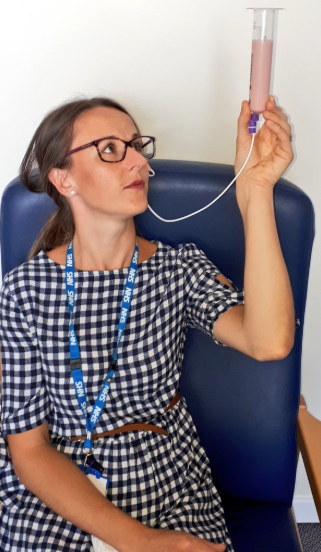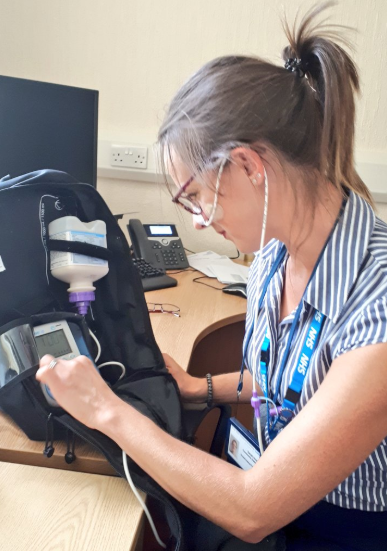“This experience is one I shall never forget” – a dietitian tries life with a feeding tube
Our community nutrition and dietetic service currently care for around 100 adults in Barnsley who have a feeding tube – a device used to provide nutrition to people who can’t take it by mouth. Team leader Sarah Armer has been a dietitian for almost 13 years, 8 of which she has spent as a tube feeding specialist.

During this time, she’s gained a vast amount of specialist knowledge and skills, although has never experienced being fed via a tube herself. She chose to try it to gain first-hand insight into some of the challenges our patients face. Sarah explains:
“Patients who either are unable to take any nutrition orally or who are unable to meet their nutritional needs by oral intake may be fed enterally, i.e. by a tube. This may be due to neurological disorders affecting swallowing, head and neck cancer or oesophago-gastric diseases. A dietitian colleague at Barnsley Hospital inserted my tube for me. It was a little uncomfortable but not painful, and it went in easily the first time. Confirming correct tube placement is essential when feeding via a nasogastric (NG) tube: before anything is administered via an NG tube an aspirate must be obtained (drawing out some of the stomach contents) to confirm the pH is 5.5 or below, which indicates the tip of the tube is in the stomach.
“I started to get used to the tube after a couple of days. Initially I found it quite time consuming, particularly having to check the pH to confirm tube position several times each day. This was even more frustrating when I was unable to obtain an aspirate to check the position of the tube. We advise patients to lie on their left side if they can’t obtain an aspirate; I’m not sure why I was so surprised when this worked for me too!
“It was incredibly interesting to feel the sensation of feed and water going through the tube to fully appreciate some of things our patients feel. It felt cold passing along the tube and I was aware of it at the back of my throat. Feeding too quickly or too much at once made me feel a little uncomfortable. These are things I always discuss with patients but it is invaluable to have first-hand experience to be able to truly empathise.

“I tried to fit in as many scenarios patients face during the time I had the tube in: different methods of feeding (pump and bolus feeding), water flushes, and have had a full day of tube-only nutrition (no food). It’s also been an enlightening experience doing everyday things that I hadn’t considered with a feeding tube: washing my face, washing my hair, going for a run. Mealtimes are also very social occasions and while I’ve sat with my family at mealtimes, it’s not the same as enjoying food with them. My children have shown a real interest and have enjoyed feeding me and helping check the pH.
“This has been a fantastic opportunity to show what allied health professionals can do, and to hopefully address some misconceptions about the work of dietitians. Additionally, I hope it will encourage and inspire others to consider this as a profession.
“This experience is one I shall never forget. Although my daily job entails advising patients about tube feeding, problem solving and trouble shooting, having this direct personal experience will enable me to better understand some of the issues our patients face every day. I now have a new level of empathy and compassion for tube fed patients.”